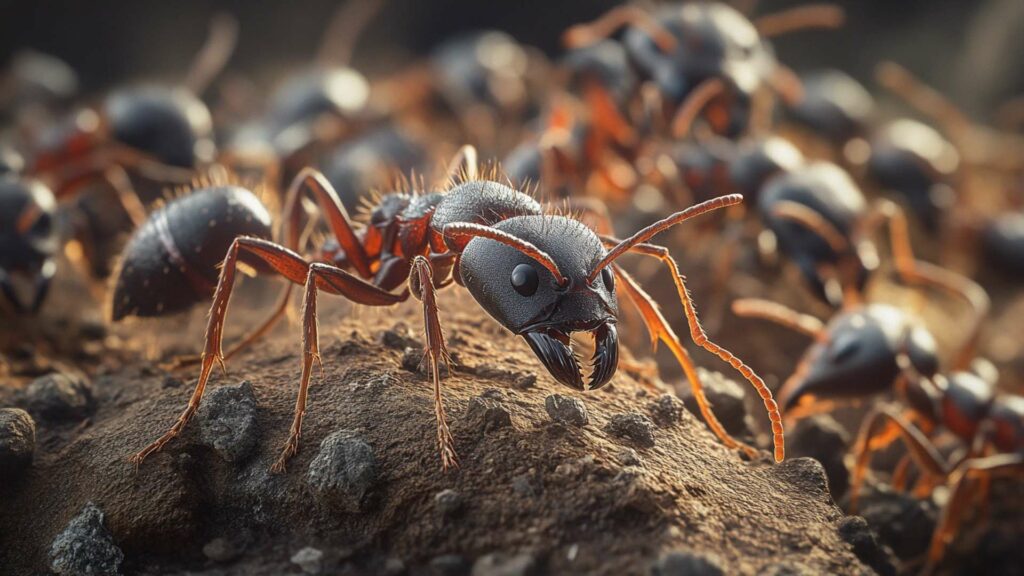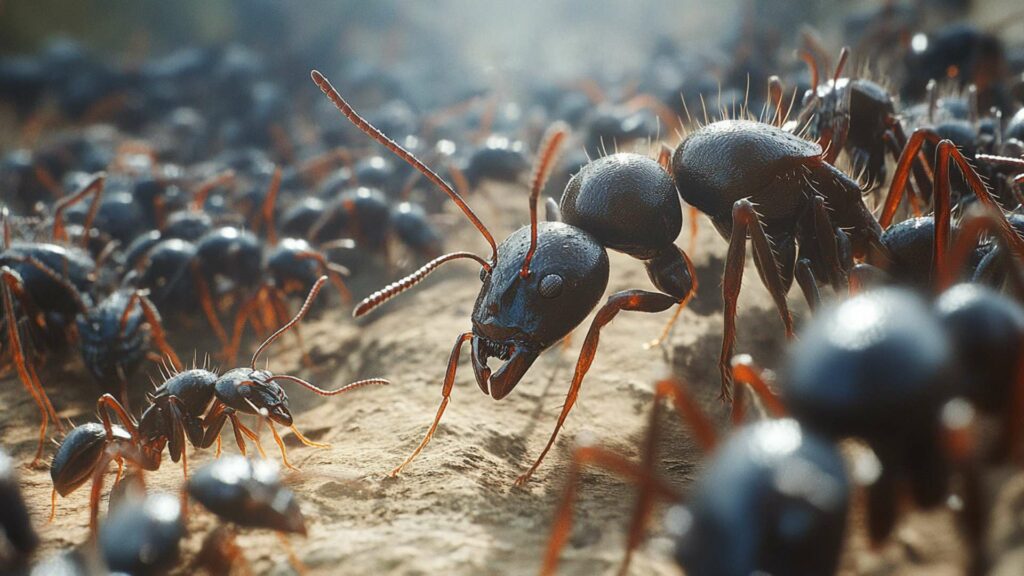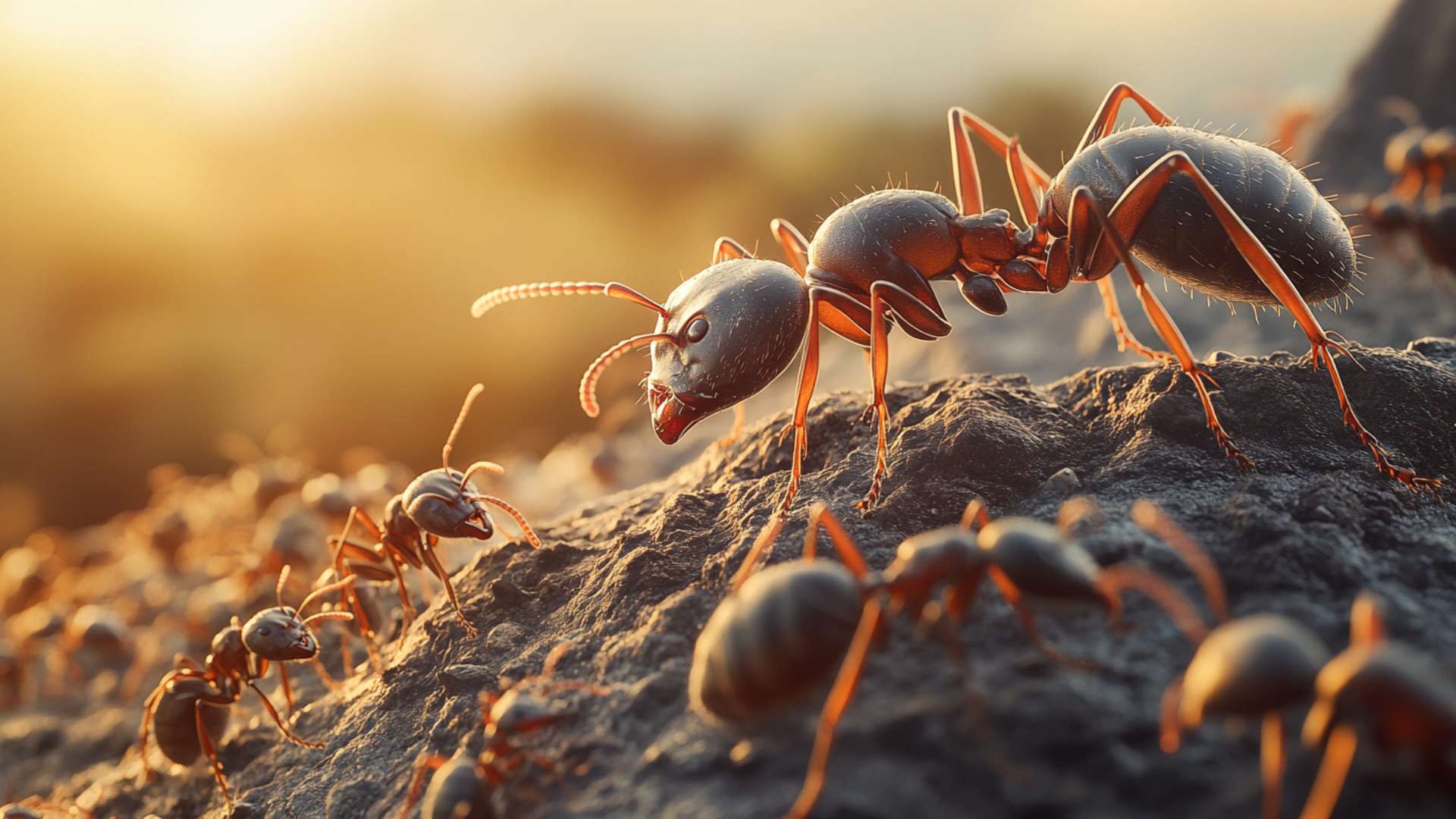Ants, those industrious little creatures that scurry around our picnics and invade our kitchens, are not just annoying pests. They are fascinating beings with a complex reproductive cycle that relies heavily on eggs. Understanding the role of eggs in ant reproduction is key to unraveling the mysteries of their colonies and gaining insight into these tiny marvels of nature.
Overview of Ant Life Cycle
Before we delve into the intricacies of ant egg-laying, let’s take a moment to appreciate the overall life cycle of these remarkable insects. Like many other insects, ants undergo complete metamorphosis, meaning they go through distinct stages: egg, larva, pupa, and adult. The egg stage is where it all begins – the starting point for an individual ant’s development within the colony.
The ant life cycle first begins when an ant queen mates with males from neighboring colonies during her nuptial flight. Once fertilized, she establishes a new nest site and starts laying eggs.
These eggs serve as the foundation for building up the colony’s population. As they hatch into larvae and eventually pupate into adults, they become integral members of their respective castes – workers or reproductive colony members.
Explanation of the Role of Eggs in Ant Reproduction

Eggs play a crucial role in ant reproduction by ensuring the continuation and growth of their colonies. They are not mere reproductive vessels; they represent hope for an expanding community striving for survival and success.
Each egg contains genetic information passed down from both parents and holds the potential to give rise to a new colony of workers or future queens. The sheer number of eggs produced by ant queens is astounding.
Queens have specialized organs called ovaries that enable them to lay hundreds or even thousands of eggs throughout their lifetime. These new eggs are necessary to replenish the worker force, maintain the colony’s productivity, and ensure the survival of the ant community.
Without a steady supply of fresh eggs, an ant colony would struggle to thrive and may eventually perish. Understanding ant reproduction starts with comprehending the significance of eggs in their life cycle.
From humble beginnings as tiny specks within ant colonies, these fragile structures give rise to all the other ants we observe scurrying around in search of food or building intricate nests. So next time you come across an ant bustling about its business, take a moment to appreciate the fascinating journey it embarked upon from that tiny egg nestled deep within its thriving colony.
Ant Queens and Their Egg-Laying Abilities

When it comes to reproductive members within an ant colony, the queen ants take center stage. These regal creatures occupy a position of utmost importance for most ants, as they are responsible for the perpetuation and expansion of their colonies. The queen’s primary role is to lay eggs, ensuring the survival and growth of her ant community.
Queen ants differ significantly from other ants in both appearance and abilities. In most species, queen ants are noticeably larger than their worker counterparts.
This size difference between queens and males is due to their enhanced reproductive capabilities. While worker ants possess underdeveloped ovaries or none at all, queen ants have fully functional ovaries that allow them to lay eggs throughout their lives.
The task of laying eggs is a queen ant’s only job within the colony. This duty can be likened to a lifelong commitment that ensures the continuation of her lineage.
Queen ants possess an extraordinary ability to produce vast quantities of eggs over their lifetimes, with some capable of laying hundreds or even thousands daily. The process begins when a new queen mates with male ants during what is known as a nuptial flight.
Following mating, she stores millions of sperm in her spermatheca—a specialized organ dedicated solely to this purpose—which allows her to fertilize eggs throughout her life without any further contact with males. Once settled into her role as monarch, she will dedicate herself entirely to fulfilling her biological destiny by laying eggs continuously.
From Egg-laying Queen to Motherly Figure
As time passes and the colony expands, the number of new queens may increase within the nest. In some ant species, these new queens develop from other larvae through a process called complete metamorphosis before emerging as potential leaders for new colonies.
However, in most species, the primary queen retains her dominance and continues to lay eggs while others remain as backups. This hierarchical system ensures the survival and stability of the ant community.
The queen’s ability to lay eggs is not solely an act of reproduction; it also serves as a mechanism for maintaining social order within the ant colony. The pheromones produced by fertile queens play a crucial role in regulating worker behavior and inhibiting the development of other females’ reproductive organs.
Thus, beyond egg-laying, queens assume a motherly figure in their colonies, nurturing and guiding their worker offspring to ensure the success of their thriving societies. Understanding the pivotal role that queen ants play in ant colonies gives us valuable insights into these complex social insects’ dynamics.
Their exceptional egg-laying abilities contribute not only to population growth but also to maintaining harmony within their highly organized communities. So next time you come across these tiny yet mighty creatures on your property, take a moment to appreciate the remarkable life cycle they undergo and the crucial role played by their royal leaders—the queen ants.
The process of ant egg-laying
Ants have a fascinating and intricate method of reproducing. The process begins with the mating flight, during which young queen ants and male ants take to the air in search of mates.
This event is often seen as swarms of flying ants, and it usually occurs during warm seasons. After mating, the males soon die off, leaving the inseminated queens to begin their journey in establishing a new nest.
Once inseminated, the queen ant stores the sperm inside her body for later use. Throughout her life, she can produce thousands or even millions of eggs from this stored sperm supply.
Interestingly, some ant species can control whether an egg is fertilized or not. Fertilized eggs of ants develop either into female worker ants or new queens, while unfertilized eggs develop into male ants.
The location where ants lay their eggs varies depending on the species and environmental factors. Some ant species construct specialized chambers within their nests for egg-laying purposes, while others prefer to deposit them in hidden crevices or soil cavities outside the nest. The queen ant carefully selects these locations to ensure optimal conditions for egg development.
In some species, such as Argentine ants (Linepithema humile), they establish multiple nests connected by trails known as “supercolonies.” In such cases, queens may distribute their initial brood across several nests to increase chances of survival. Additionally, certain types of parasitic ants exploit other insect colonies by infiltrating them and laying their own eggs among those of unsuspecting hosts.
It is worth noting that worker ants play a crucial role in caring for these precious clusters of new life. They diligently maintain suitable humidity levels by licking the eggs regularly or moving them between different parts of the nest for temperature regulation.
This meticulous attention ensures the survival and growth of the developing ant pupae inside the eggs. By understanding the intricate process of ant egg-laying, we gain insight into their remarkable reproductive strategies.
From the mating flights to the selection of ideal egg-laying sites, ants have evolved fascinating mechanisms to ensure a successful continuation of their species. The coordination between queen ants, worker ants, and their surroundings showcases both the complexity and adaptability that allows these pesky yet mesmerizing creatures to thrive in different environments.
Types of Ant Eggs and Their Characteristics
When it comes to ant reproduction, understanding the distinction between fertilized and unfertilized eggs is vital. Fertilized eggs develop into female ants, including both workers and queens, while unfertilized eggs develop into fertile male ants, also known as drones. This intriguing process determines the future members of an ant colony. Ant eggs exhibit remarkable diversity in terms of shapes, sizes, and colors across different ant species. The size of an ant egg can vary from barely visible specks to miniature pearls that catch the eye with their smoothness and luster. Similarly, their shapes range from oval to elongated or even slightly curved. As for colors, ant eggs often display variations too; some appear translucent white or pale yellow while others can be pale brown or even black.
A Kaleidoscope of Diversity: Ant Eggs Across Different Species
Each ant species presents its own unique characteristics when it comes to their eggs. For instance, army ants boast tiny but numerous eggs that resemble small grains of sand due to their minuscule size and light coloration.
On the other hand, carpenter ants lay relatively large eggs that are more noticeable due to their darker hue. Interestingly, some species have developed specialized adaptations related to the shape or placement of their eggs.
Leaf-cutter ants are known for producing egg bundles consisting of multiple interconnected chambers within a single structure called a “raft.” This arrangement helps protect all the eggs and developing larvae from external threats as they float on water during floods or heavy rains. Ants have evolved numerous strategies for maintaining successful colonies through their reproductive members—eggs being at the very beginning of this intricate cycle.
By observing and appreciating the diversity in shape, size, and color among these fascinating little orbs within different ant species, we can gain a deeper understanding of the remarkable world of ants and their complex life cycles. (Note: It is important to remember that the examples given above are not exhaustive and represent only a fraction of the diverse characteristics found among ant eggs.)
Egg Care within an Ant Colony

As we delve deeper into the fascinating world of ants, it becomes evident that their social structure extends beyond mere cooperation. Worker ants play a crucial role in maintaining the delicate balance within their colony, including tending to the precious eggs.
Once a queen ant has laid her initial brood, worker ants take charge of nurturing and safeguarding these tiny life forms. The worker ants exhibit an unwavering dedication to ensuring optimal conditions for egg development.
Their primary responsibilities include regulating temperature and humidity levels, protecting the eggs from external threats, and providing essential nutrients. These diligent caretakers delicately hold each egg in specialized chambers within the nest, using their mandibles to gently move and rotate them as needed.
Ruthless Protectors: Guarding against Predators and Environmental Factors
In the vast wilderness of nature, predators lurk at every corner, eager to snatch away anything vulnerable. Ant colonies have evolved a repertoire of strategies to safeguard their precious eggs from hungry intruders and harsh environmental conditions.
One such method involves constructing elaborate nests with intricate tunnels and chambers deep within the ground or hidden in tree trunks. Ant colonies employ chemical signals called pheromones as a means of communication among colony members.
These pheromones serve dual purposes when it comes to egg protection. First, they act as an alarm system against potential predators or invading insects by alerting nearby workers who can swiftly respond in defense.
Second, certain pheromones help maintain that ideal temperature and humidity necessary for healthy egg development. Furthermore, some ant species have developed unique physical adaptations for enhanced egg protection.
Carpenter ants, for instance, bore into wood-creating galleries where they lay bare their eggs deep inside protected chambers—safe from prying eyes or other brood parasites. This architectural prowess helps thwart potential predators and safeguards the survival of future ant generations.
From Nurture to Nature: Nurturing Eggs for the Future
The worker ants’ unwavering commitment to egg care stems from their understanding of their vital role in sustaining the colony. As eggs progress through various stages, from freshly laid to larvae stage and eventually pupae, worker ants adapt their care accordingly. They diligently adjust temperature and humidity levels, ensuring optimal conditions for the eggs’ healthy development.
Throughout this nurturing process, female worker ants remain acutely attentive, taking care not only of eggs laid by the queen ant but also those belonging to other workers or even new queens produced by the colony. Their selflessness extends beyond immediate kinship, emphasizing their dedication to preserving and expanding their colony’s strength.
Understanding these intricate mechanisms surrounding egg care within ant colonies provides us with a glimpse into the remarkable complexity of these diminutive yet highly organized creatures. It serves as a reminder that even creatures as seemingly insignificant as ants play crucial roles in maintaining ecological balance while demonstrating impressive social dynamics worthy of our awe and admiration.
Development stages from egg to adult ant
The journey of an ant’s life cycle begins with the laying of eggs by the queen ants, who are the reproductive members of the colony. These tiny eggs, usually white and oblong-shaped, are carefully tended to by worker ants. Within a few weeks, these unfertilized eggs start undergoing development.
The process begins with the emergence of a larva from each egg. Once hatched from its protective shell, the larva is fed and nurtured by the adult worker ants from within the secure confines of the nest site.
They provide it with nutrient-rich secretions called “brood food” or “larval saliva,” which are produced in specialized glands. This highly nutritious diet allows the larva to grow rapidly and undergo several molting stages as it sheds its exoskeleton to accommodate its increasing size.
As the larva continues to grow and mature, it enters a fascinating stage called pupa or cocoon. During this phase, it undergoes a remarkable transformation inside a protective silk-like casing spun by worker ants.
The pupa appears motionless and resembles a miniature version of an adult ant, although its body parts are not fully developed yet. Inside this pupal case, hidden away from prying eyes or any potential threats, metamorphosis is taking place at an astonishing pace.
Within this secluded sanctuary, various physiological changes occur within the body of the developing ant: organs form and differentiate; wings develop (in species that have them); legs elongate; and coloration patterns emerge. After spending some time in this resting state, where external food intake is minimal or non-existent for most species, an extraordinary event transpires—the fully formed adult ant emerges from within its protective cocoon.
With its exoskeleton hardened and its wings, if present, fully developed and functional, the adult ant is finally ready to venture out into the world and take on various roles within the colony. The development stages of ants from eggs to adult individuals involve a truly remarkable series of transformations.
From an egg hatches a larva that undergoes multiple molting stages while being diligently cared for by worker ants. The larva then enters a pupal stage, where it undergoes rapid physiological changes within a protective casing spun by worker ants.
After this transformative period, the adult ant emerges with fully developed characteristics and is ready to contribute to its colony’s functioning. Understanding these intricacies adds another layer of awe when considering these fascinating creatures that play significant roles in our ecosystems, beyond just being annoying pests at times.
Rarely Known Facts About Ant Eggs
Unveiling the Mysteries of Ant’s Egg-laying Habits
When it comes to laying and caring for eggs, ants exhibit intriguing behaviors that often go unnoticed. These fascinating facts shed light on the remarkable adaptations and unique strategies employed by different ant species. Let’s delve into the captivating world of ant eggs and discover some extraordinary secrets.
Remarkable Behaviors Surrounding Ant Eggs
In the realm of ant reproduction, there are several unusual behaviors related to laying and caring for eggs. For instance, did you know that army ants have a peculiar habit of carrying their eggs with them as they migrate?
Yes! These intrepid nomads transport their precious offspring during their relentless search for food.
The reason behind this behavior lies in ensuring the safety and protection of the developing larvae. Another astonishing fact is that some ants exhibit what is known as “egg licking” behavior.
This involves female ants gently licking newly laid eggs within the colony. Scientists believe this action serves multiple purposes: it helps regulate humidity levels around the egg, prevents fungal growth, and even transfers pheromones that provide vital communication within the ant community.
Adaptations That Set Certain Species Apart
Each particular species of ant has its own set of peculiar adaptations when it comes to laying and caring for their eggs. One example is found in leaf-cutter ants which cultivate a specific type of fungus as their primary food source.
To ensure optimal conditions for fungal growth, these industrious insects deposit tiny pieces of leaf matter alongside their eggs. As the leaves decompose, they create an ideal environment where both fungus and larvae can thrive symbiotically.
Another astounding adaptation can be observed in certain species called “slave-making ants.” These cunning creatures raid nearby colonies to steal pupae—developing ant stages between larvae and adults. Once in their possession, the newly captured pupae are carefully nurtured by their captors until they hatch as adults.
This peculiar behavior ensures a constant supply of adult workers, for the slave-making colony. As we continue to unravel the mysteries of ant eggs, it becomes clear that these tiny ova hold a wealth of wonders.
From unusual behaviors like egg licking and migrating with eggs to extraordinary adaptations observed in leaf-cutter ants and slave-making ants, the world of ant reproduction is anything but ordinary. These revelations not only deepen our appreciation for the complexity of ant societies but also highlight the incredible diversity and ingenuity found within nature itself.
Significance of understanding ant egg-laying behavior

The Hidden World Beneath Our Feet: Unveiling the Wonders of Ant Egg-Laying
Ants, those tiny yet fascinating creatures that seem to be perpetually scurrying around, have a secret world lurking beneath our feet. Understanding their egg-laying behavior can provide invaluable insights into the intricate workings of social insects and shed light on their evolutionary history. Studying how ants lay eggs not only unravels the mysteries of their life cycle but also offers practical applications in pest control strategies.
Impact on studying social insect evolution
By delving into the mechanisms behind new ant colony egg-laying behavior, researchers can unravel the complex web of interactions within a colony and gain deeper comprehension of social insect evolution. Ants live in highly organized societies where distinct individuals perform specific roles. The queen ants play a crucial role in reproduction by laying eggs, ensuring the continuation and survival of their species.
Through studying how queen ants reproduce and pass on their genes to future generations, scientists can delve into questions about reproductive strategies, genetic diversity, and even conflict resolution within colonies. Understanding these aspects helps us appreciate how social insects have evolved over millions of years to form intricate societies with specialized roles.
Relevance in pest control strategies
While ants are often admired for their industriousness and teamwork, they can sometimes become unwelcome visitors in our homes or gardens. When faced with an ant problem, understanding the egg-laying behavior offers valuable insights for devising effective pest control strategies. Knowing where queen ants prefer to establish new nests and lay eggs allows us to target those areas when implementing preventive measures or eliminating existing colonies.
By disrupting or removing eggs before they develop into larvae or adult forms, we can nip potential infestations in the bud. Moreover, understanding ant reproduction aids in developing eco-friendly pest control methods that minimize the use of harmful chemicals.
Instead of relying solely on toxic substances, scientists can explore natural deterrents or disrupt the communication and pheromone trails that ants use to navigate and locate resources. Understanding ant egg-laying behavior opens a window to a hidden world teeming with complex social interactions and evolutionary wonders.
By delving into this realm, scientists gain insights into how social insects have evolved over time, while simultaneously providing us with practical tools to tackle pesky ants that invade our living spaces. So next time you marvel at an army of ants marching in perfect order, remember that there is more beneath the surface than meets the eye – a world where eggs hold the key to understanding both their entire life cycle and our ability to coexist peacefully with these tiny yet fascinating creatures.
Conclusion:
In delving into the fascinating world of ant reproduction, we come to appreciate the intricate dance of life that unfolds within a bustling ant colony. From the several hundred queen ants who lay eggs to the diligent worker ants tending to these precious gems, each member plays a vital role in ensuring the survival and prosperity of their species.
The nest becomes a sanctuary, serving as the nurturing ground for ant larvae, pupae, and eventually adult ants. Understanding this complexity allows us to marvel at nature’s ingenious design.
As we uncover more about how different species do ants lay eggs and their eggs and care for their brood, we are continually amazed by the remarkable adaptability displayed by ants. Some species rely on a single queen to carry out all egg-laying duties, while others feature several queens collaborating harmoniously. Some ants meticulously construct elaborate nests where they carefully tend to their eggs and larvae, while others employ more unconventional methods.
For instance, certain parasitic ants infiltrate neighboring colonies and manipulate them into caring for their own young. The diversity in reproductive strategies among ants highlights their ability to thrive in various environments.
Studying ant reproduction not only deepens our understanding of these tiny creatures but also provides valuable insights that can be applied beyond entomology. The complex social structure found within an ant colony teaches us about cooperation, division of labor, and efficient resource management – all qualities that resonate with our own human societies. By appreciating how queen ants dedicate themselves solely to laying eggs or how worker ants diligently nurture the initial brood until they develop into both adult ants and members of society, we gain inspiration for collective success.
Let us celebrate these unsung heroes of Mother Nature, for their tenacity and ingenuity serve as a poignant reminder of the marvels that lie within our natural world. Do ants lay eggs?
Absolutely! But beyond this simple answer lies a captivating journey of life.
Ants exhibit an astonishingly complex reproductive cycle, from the initial laying of eggs by queens to the careful nurturing provided by worker ants. The incredible adaptability and various strategies employed by different ant species never cease to amaze us.
As we delve into the intricacies of ant reproduction, we gain not only scientific knowledge but also valuable life lessons rooted in cooperation and resourcefulness. So let us celebrate these tiny architects of nature and embrace the optimistic reminder that even in the smallest creatures lie tales of wonder and inspiration.
Dissuade Ants with D-Termination: Las Vegas’ Top Pest Control Solution!

If you’re grappling with ant problems, D-Termination is your go-to solution. Our skilled team excels at discouraging ants, rejuvenating cleanliness, and preserving the integrity of your surroundings. Bid farewell to ants—opt for D-Termination for effective pest control today!
Get in touch with us at 702-919-6310 or visit dtermination.com to schedule your ant control service and reclaim your space from these unwanted pests.
Frequently Asked Questions:
Ant eggs are tiny, oval-shaped, and usually white or translucent.
Ants lay their eggs in nests, often in secluded areas.
Ants lay eggs; they do not give birth.
Baby ants, known as larvae, are legless and grub-like in appearance.








